
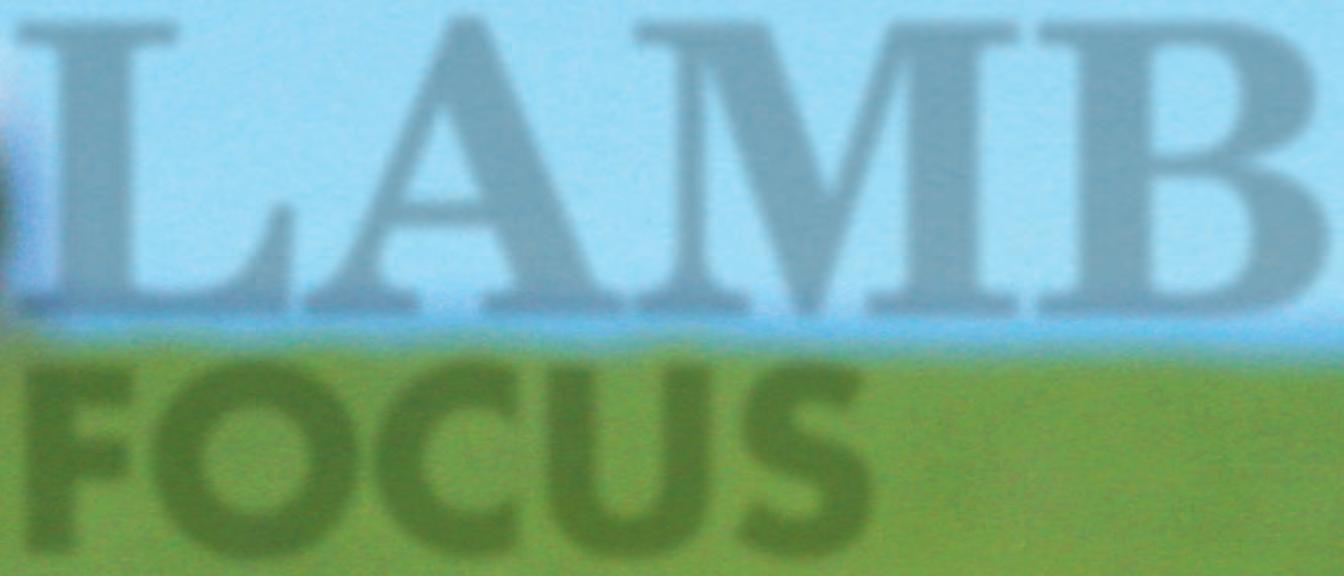











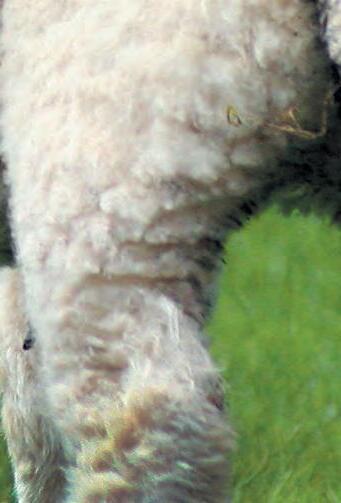

















2024 has seen the launch of Days Whiteface’s new shedding breed ”White Baldies’”
They are excited to offer their first rams this year at the on-property sale Friday October 4, 2024.
They believe they exhibit plenty of growth and carcase in a maternal shedding package.
They look forward to your feedback on our lineup of rams.
The 2024 white Suffolk rams are impressive.
They are exhibiting plenty of growth and muscle, with structural soundness.
Days Whiteface’s ASBV’s are again at the top of the breed.
There are plenty of low birth weight, lambing ease options to compliment the strong growth and carcase ASBV’s.
A highlight of the 2024 offering will be the first progeny of the new $20,000 sire, Warburn 210303.
They are certainly what the industry requires, exhibiting their fathers’ outstanding carcase and growth.
He is also in the top 5 per cent of the breed for IMF and shear force.
Days Whiteface’s other new sire this year is Farrer 200086, he is a lambing ease and IMF specialist. He has combined well with the flock to offer
YEARS of careful selection and detailed performance recording have proven their worth for Cashmore Oaklea, with the stud being one of the largest suppliers of maternal genetics in Australia.
The Cashmore Oaklea team have a united focus on producing an easy-care sheep that will provide them and their clients with the best returns for the least inputs. The major focus on increased fertility, milk production, growth rate, carcase attributes and resistance to internal parasites continues to remain at the forefront for Cashmore Oaklea.
Their whole aim is to produce sheep that will perform well and stand up to challenging conditions.
With an extremely dry season across most of South Australia and Victoria, the resilience of composite sheep, specifically with Cashmore Oaklea bloodline has been evident. With stud sheep run under some very hard conditions in large mobs, only the best sheep come to the top.
With one of the dryest seasons on record, the resilience of Cashmore Oaklea sheep has been proven.
Cashmore Oaklea’s annual ram sale of approximately 500 elite maternal composite, 300 nudie rams and 35 Terminals will be held on Friday, October 4 2024, conducted exclusively on Auctions Plus.
See Cashmore Oaklea Sales page for further information.

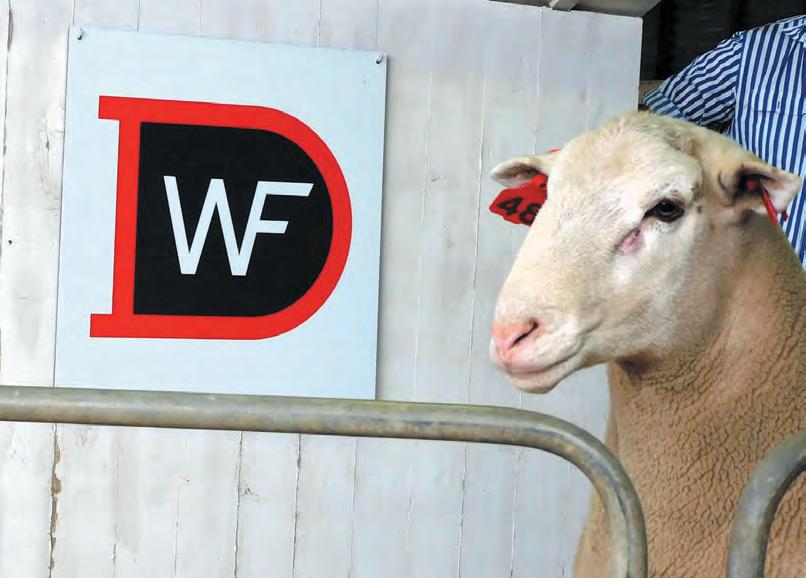

an exciting group of progeny.
A couple of the top end rams are sired by him.
Last years top seller Days 220266 who sold for $22,000 to Harry’s Well was used as a ram lamb and certainly bred very well and is in the top 5 per cent on all indexes Other Homebred Sires, 210167, 210155 and 210332 are well represented and offer different strengths while having the commonality of all having resilience being in the top 10 per cent for low WEC.
their Maternal Composite offering gets stronger every year, they are certainly worth considering if you are looking at options for a self-replac-
ing flock.
The current clients are exceptionally pleased with their weaning rates, growth rates and carcase attributes.
Leading the charge is homebred sire 20M036. He is in the top 5 per cent on the MCP+ index and is a standout for low mature weight relative to his post weaning weight.
He is also in the top 5 per cent for Eye muscle depth.
My number is 0428521630 and welcome a call anytime to talk about the programs and how they could benefit yours or to organise a time for a visit.
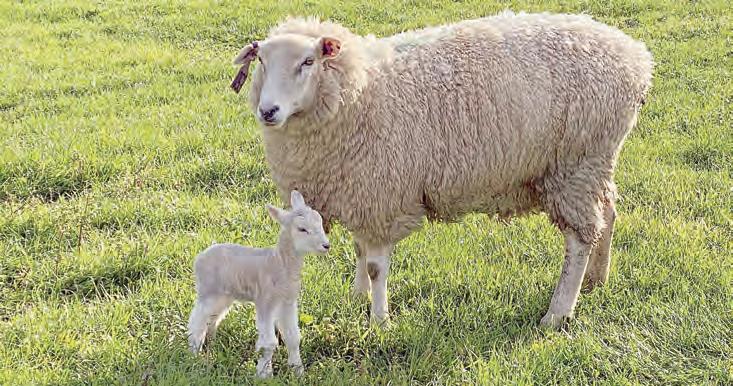
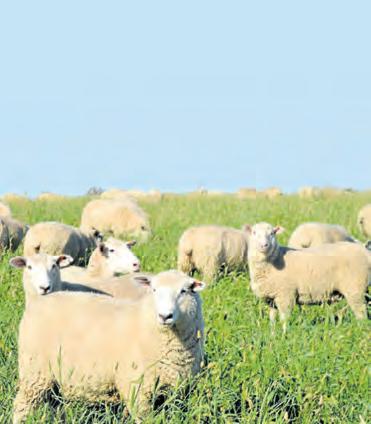



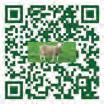






WHEN you select your new White Suffolks from Detpa Grove this year, you can rest assured they will adapt to any environment.
Detpa Grove principal David Pipkorn has sold sheep to all Australian states, into New Zealand, the US and China.
“All these markets have appreciated the tremendous growth, high meat yield, good constitutions and balanced structure - all traits contributing to our sheep thriving in a wide array of climates and production systems,” he said.
“This includes the extremes of 45 degrees in Australia through to minus 30 degrees in Mongolia and the oxygen thin environment of 3.6km above sea level in Tibet.
“And ranges from the intensive handling and shedding of sheep in those extreme cold temperatures to large scale commercial operations here in Australia with thousands of ewes producing prime lambs.”
This adaptability has helped this year’s spring sale stock, which have had to face particularly tough weather conditions at Depta Grove.
“The flock rams are kicking on and looking great as usual despite the dry season.
“Meanwhile all of our ewes got through the recent dry time without grain feeding,” Mr Pipkorn said.
“The dry hasn’t hindered the ewe’s performance either; “We have also had an impressive fecundity display during lambing this year, with 55 sets of triplets in the first 600 lambs born..
“Things are starting to look up, we have been able to ease off the hay feeding, and it is encouraging to see lamb prices back on the upward trend.
“All indicators are for a strong and healthy outlook for lamb in the spring.”
Detpa Grove will offer 250 White Suffolk rams and ewes at their 36th Annual On-Property Sale, including stud ewes, stud rams, specially selected rams and flock rams.
This will once again feature progeny of homebred super sires Detpa Grove REGAL 200477 and Detpa Grove NOBLE 180374, along with artificial insemination sire Ella Matta 210270.

EM 210270 has been the leading Lambplan ram in the country, and currently has Australian Sheep Breeding Values in the top one per cent for post weaning weight, lambing ease direct and shearforce, as well as its Terminal Carcase Production Index (164.92).
“We handpicked 17 rams for this drop and target mated them, including Ella Matta 210270, who we used carefully over a number of ewes,” Mr Pipkorn said.
“The challenge for me is keeping everything balanced while improving key traits simultaneously.
Growth is king and we are seeing that here with lambs being weaned at three and a half months reaching 74kg, and that has been achieved with just grass and milk.”
Eating quality is another of the traits considered in the balance at Detpa Grove, and again this year there will be rams by high eating quality sire Yanco 200156 on offer.
The sire is in the top 1 per cent on Lambplan for both intramuscular fat and shearforce.
“He has a very high intramuscular fat and extremely tender meat - we are not pushing to breed Wagyu sheep, we just want to make sure the consumer doesn’t get a bad experience because generally, lamb is very very good,” David said.
Last year, Detpa Grove cleared 206 lots at auction, with stud rams topping at $12,500, flock rams to $2200, and the total sale averaging $1723.
The 2024 Detpa Grove Annual On-Property Sale will be conducted at 961 Lorquon Rd, Jeparit, Victoria, as well as being interfaced with AuctionsPlus.
Inspections will be available from 10am sale day, with ewes starting at 11.30am and rams at 1pm.
The Pipkorn family welcome valued clients, friends and supporters to their Annual On-Property Sale.
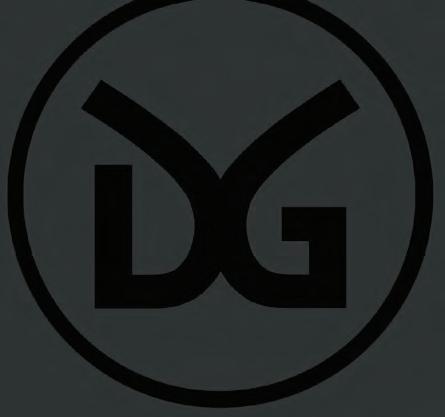

For the latest news andsale updates, please visit www.detpagrove.com or Detpa Grove Facebook and Instagram page.



FOR the James Family of “Coolawang” it is about more than just breeding sheep, it is a way of life and a passion that has built a very successful business.
Over a journey that has spanned three generations and now the fourth arriving, one could suggest that same passion for agriculture and livestock that their parents and grandparents possess may carry into the future and if genetics mean anything, you could believe so.
For the story to begin we roll back nearly 50 years when Trevor James left school and headed home to the family property at Waitpinga on the Fleurieu Peninsula where he joined his father Lionel on the family’s grazing property and a passion for breeding sheep was born.
Trevor and his parents commenced using Border Leicester rams in their merino ewe program to produce the very hardy Border LeicesterMerino first cross ewe that was sought by the Fleurieu prime lamb producers of the time.
A breeding strategy that would span the test of time and exist within the family business and complement a sheep and wool program for the next 47 years.
Today Trevor and wife Judy along with son Lachie, wife Olivia and their two infant daughters Florence and Scarlett are farming at Mundulla West on an aggregation of 1720 hectares where the foundation property was purchased in January 1985, “Coolawang”
“Our farming practices have come along way over that time with the loamy country that was semi productive when purchased now successfully growing productive crops and strong pastures on clayed soils that have more than doubled our farming capacity,” Trevor said.
The business is based on a complement of farming and grazing with crops of cereals and legumes grown in rotations to provide areas for established lucerne based pastures that provide ide-
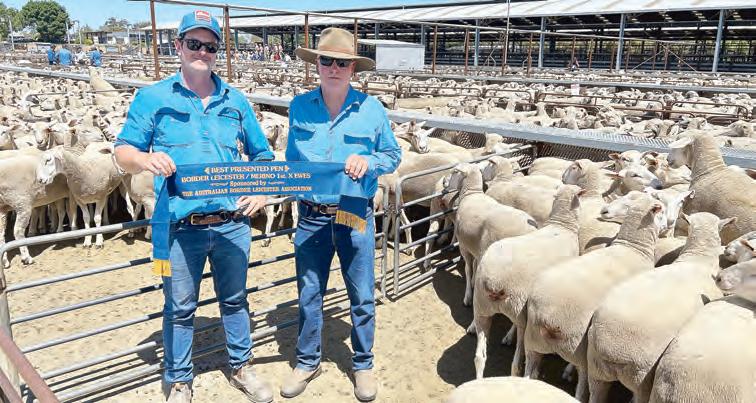
al grazing conditions for the commercial and stud program that makes up this unique enterprise.
Sheep are an integral part of the business with a large commercial self-replacing merino flock of large framed, plain bodied ewes that are producing a quality 20micron fleece.
With a selection of the flock also forming the nucleus for the Border Leicester – Merino first cross production unit that the James family has become renown for producing.
A feature of this fine-tuned business is the very successful and highly regarded “Coolawang” Border Leicester Stud.
Trevor and Judy had founded the stud out of necessity.
“With the commencement of breeding first cross progeny back at Waitpinga and struggling to secure a quality and consistent group of Border Leicester sires, we decided to purchase a group of
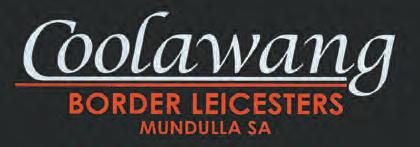

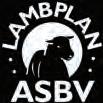


pure ewes to breed their replacement rams,” Judy said.
Consequently, this selected group of ewes led to the foundation of the stud in 1980, and to say the rest is history would be an understatement.
The family has committed 44 years to successfully breeding Border Leicester sheep at an elite level and have achieved feats that will be difficult for others to replicate.
With ten years of showing at the highest competition of royal shows and over that time the stud achieving two Supreme Interbreed Championship titles (2015 and 2019), nine Champion Ram titles, as well as on property record sale results of an Australian Record Price for a Border Leicester Ram, firstly in 2015 at $18,200 and then superseding that in 2020 at $27,000.
For the family the essence of what they are about is the commercial attribute of their programs which is reflected in the success they have achieved with their merino and first cross breeding.
The terminal side of the Coolawang business is designed to produce productive high yielding carcase crossbred lamb and merino wether lambs that are fed on to heavy export weights on pasture or through the feedlot and are readily sought by the trade.
While the merino ewe flock must individually produce a quality fleece and rare a high percentage of lambs to weaning annually, traits that are a major selection criterion in the finally tuned breeding program at Coolawang.
The breeding of first cross Border Leicester – Merino ewes has been the component of the Coolawang farming operation which has been the most transparent part of the James family business for nearly five decades.
Commencing back in the day with an annual draft offered at what was the states “Blue Ribbon” event at Strathalbyn, where Trevor reflects on the tops of the draft in 1990 received $59 in a year when sheep were near worthless on the back of the demise of the wool reserve price scheme.
The decision was made in 2004 to re-enter the auction scene with their first cross ewes, offering a draft of one year old ewes at the ‘Blue Ribbon”
feature sale in Naracoorte, which would create a dynasty of success for the James’s.
The lead of the draft was successful in winning the highly contested blue ribbon for the best presented pen and went on to sell for the top price of the sale which reflected a nation record price for the breed sold at auction in Australia at that time.
The tradition of blue ribbons, top price, highest average and national records has continued throughout the years of offering sheep annually at the Naracoorte feature sale.
As Lachie suggests, these results do not occur at random, it is through meticulous management and preparation of sheep from conception to sale that allows them to present at their best but more importantly the genetic profile of the flocks and the continued investment in performance through leading sires that has allowed us to have the strength within the article.
Coolawang has continued to place a strong emphasis on every dollar value that has a reflective trait within the flock profile – fertility, growth, muscle, wool, micron, and cut are strong pillars of selection that must then result in survivability and number of lambs weaned.
Tools such as lambplan and genomics have put the science behind the visual aspect of selection, which then is complemented by a strong animal ethic and sustainability program as well as an ongoing rigorous biosecurity campaign within the flock.
This is substantiated by the flock being OJD Monitored MN3 since 2001 along with the use of Gudair Vaccine to provide the flock providence of MN3(V) together with annually testing for Brucelosis to retain an Accredited Free status across the flock.
The vigilant management and movement practices of any livestock on or off the property is a high priority of the James’s and remains key to presenting a healthy, clean article to their customers.
The entire family pride themselves on the success of a business that is committed to the future of agriculture for the generations to come. This is evident by the foresight and support that the team offers to their clients that purchase their first cross ewes, select stud sires and stud breeding ewes or purchase any of the 300 Border Leicester flock rams that are offered at auction or are selected privately.
The strength of relationship is paramount and highly valued by the family, who are quick to reflect on the highlight of the business throughout the years has been the friendships made and the ongoing support and long-term relationships they have with clients and agents alike.
The family is humbled by the success of their clients both stud and commercially and are thrilled to see the “Coolawang” name appear in stud pedigree’s or written on placards in saleyards.
“The strength and value of our product is reflected in our client’s livestock” - a statement that reflects the commitment this generational business has toward the sheep and lamb industry and the people within it.

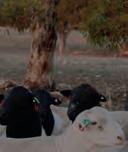

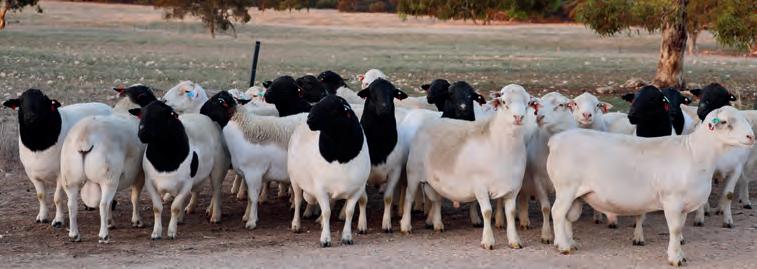
THE well-respected sheep industry resource
Making More From Sheep (MMFS) has been relaunched with significantly updated and new information for sheep producers.
MMFS is a one-stop-shop for Australian sheep producers and has been updated to include the latest sheep industry research, tools and information on husbandry and management, including resources, videos, apps, technologies, podcasts and fact sheets.
MMFS began development by Australian Wool Innovation (AWI) and Meat & Livestock Australia (MLA) in 2006, with its first release to industry in 2008.
Since then, AWI and MLA have continued to invest in the development and update of MMFS as a key resource for the Australian industry.
The MMFS offering has now expanded to include 12 Modules, animal health fact sheets and presentations and conference recordings, and for the first time ever in 2024, the Making More From Sheep eLearning course, which is housed on both the AWI and MLA eLearning platforms.
AWI National Extension Manager Emily King said The MMFS package of resources is an “essential guide” for sheep production.
“The key production principles are covered in the modules but core to its usefulness is the linking to hundreds of other industry resources and workshops to delve deeper into any specific topic,” she said.
“The 12 Modules are the backbone of MMFS and cover all aspects of sheep production – sheep and human wellbeing and welfare, wool, lamb and sheepmeat production, sustainability, productivity and profitability across breeding, reproduction, pasture and feedbase, generated from years of research and on-farm experience.”
MMFS Modules can be used as a standalone resource to look for information for something specific or used as a whole in a manual style application.
The best-practice principles covered in MMFS support a sustainable and profitable sheep and wool operation, helping to reduce costs and optimise production while minimising risk in an ever-changing environment.
The MMFS package of resources is part of AWI and MLA’s continuing commitment to delivering on-farm knowledge and technology to help producers increase the long-term sustainability and profitability of sheep and wool production, paving the way for a successful industry for the next generation.
MLA General Manager, Research, Development and Adoption Dr Jane Weatherley said that the MMFS relaunch comes at a timely moment in the Australian sheep industry.

“The MMFS relaunch is a key component of MLA’s adoption and extension programs and another tool to assist on-farm decision making,” Dr Weatherley said.
“With the Australian sheep and wool industries facing a number of big changes in coming
GRAZING permit fees are set to be waived for some farmers in the Glenelg Shire.
Some are currently experiencing feed shortages and financial hardship due to below-average rainfall during autumn and winter.
Autumn and winter are a critical time for adequate rainfall for cropping, livestock, and dairy production.
Council roadsides may be used to help with grazing and feed shortages, however under the
General Local Law 2018 (clause 4.18) a permit is required.
To help with this process the fee for the permit, $130 a year, will be waived for the 2024-2025 financial year as a result of the hardship farmers are experiencing.
Farmers wishing to apply for a grazing permit are encouraged to visit the Glenelg Shire Council website.

years, the relaunch of this program will help keep producers up to speed on the latest technologies and knowledge in order to keep producing happy and healthy sheep.”
To access the Making More From Sheep Manual and associated resources visit www.making-
with significantly updated and new infor-
morefromsheep.com.au
Check out Making More From Sheep eLearning at: AWI: www.woolmarklearningcentre.com/program-library/wool-production-program/ MLA: https://elearning.mla.com.au/library/
A well-known rural charity is urgently assisting farmers who are battling increased levels of mental ill-health in recent months.
Rural Aid provides critical support to farmers affected by natural disaster through financial, wellbeing and fodder assistance.
Chief executive John Warlters said primary producers are feeling overworked, underappreciated and anxious.
“In a recent Rural Aid study, one in two farmers said they’ve felt their mental health decline in the past year,”he said.
“76 per cent of our farmers rated their mental health as poor, very poor or average.”
“These numbers show that all is not well on the farm.
“It’s a sentiment echoed across the industry; Rabobank’s Rural Confidence Survey has shown farm confidence has plummeted in the past three months.”
Rural Aid’s Mental Health and Wellbeing Manager, Myf Pitcher, said weather conditions, biosecurity concerns, and disaster recovery are on farmers’ minds.
“Our counselling team is making a really important difference every day, we’ve been all over the country supporting primary producers,” Ms Pitcher said.
“From hay drops in South Australia, to water tank deliveries in Western Australia, and resilience and recovery conversations in Queensland, our mental health and wellbeing team have been working overtime to assist farmers with the challenges they’re currently facing.”
Mr Warlters said the record dry conditions in the south and west of the nation are proving especially difficult for farmers to deal with.
“Rural Aid has organised and executed a support drop of hay, stockfeed or emergency household drinking water at the rate of roughly one per day over the last four weeks. The demand for hay in South Australia has been particularly strong.”
“But, Rural Aid can’t do any of its vital work without the generosity of the Australian public,” Mr Warlters added.
“With tax time just around the corner, it’s a good time to consider a donation to Rural Aid.”
“Thank you to every single person who has dug deep for our mates in the bush in their moment of need,” Mr Warlters said.
To donate to Rural Aid, or to find out more about Rural Aid’s mental health and wellbeing program, visit www.ruralaid.org.au or call 1300 327 624.
MEAT & Livestock Australia’s (MLA) Sheep Genetics team has announced a new update to Flock Profile at LambEx in Adelaide.
In September, the highly popular Flock Profile, used by Merino producers to benchmark the genetic merit of their flock, will be updated to include additional traits of Weaning Rate and Condition Score as well as new MERINOSELECT Indexes.
The new MERINOSELECT Indexes were released earlier this year.
They are Fine Wool (FW), Wool Production (WP), Sustainable Merino (SM) and Merino Lamb (ML).
These indexes are modelled to represent common production systems in Australia and help drive genetic gain in the Merino industry.
Weaning Rate (WR) describes the genetic difference between animals for the number of lambs weaned per ewe joined.
A ram with a higher Australian Sheep Breeding Values (ASBVs) ASBV for WR will produce daughters that wean more lambs.
Condition Score (CS) describes the genetic difference between the condition of ewes at joining.
It is expressed in the same units as the Lifetime Ewe Management (LTEM) condition scoring guidelines.
A ram with a higher ASBV for CS will produce ewe lambs that have a higher condition score at weaning.
According to the manager of Sheep Genetics at MLA, Peta Bradley, the updates enable commercial merino producers to access a comprehensive snapshot of their genetic merit for key production, health and welfare traits.
“Flock Profile is a cutting-edge tool allowing commercial Merino flocks to benchmark their genetic performance relative to industry via Australian Sheep Breeding Values and indexes,” Ms

Bradley said. “Flock Profile uses the information from 20 randomly genotyped animals from a current drop of ewes, providing an accurate snapshot of a flock’s genetic merit.
“Currently, Flock Profile benchmarks key production traits including industry indexes, fleece quality, growth, carcase and health and welfare.
“Developed by the leading research scientists at the Animal Genetics and Breeding Unit
BOOSTING the physical and mental health of rural communities is the focus of a new partnership between grassroots health initiative Fat Farmers and charity the Hospital Research Foundation Group (HRFG).
The HRFG is now a Fat Farmers major health partner, to help the program expand into more towns and encourage exercise and social connection amongst isolated farmers. The program is a farmer-led initiative which was founded on the Yorke Peninsula 12 years ago when three 40-something farmers joked they were getting ‘fat’ once their footy careers had ended. Since then, the fitness venture has grown to be in 18 towns across South Australia, New South Wales and Victoria with about 150 participants, meeting a huge need in boosting rural health amongst men in particular.
Fat Farmers accept all people regardless of whether they are ‘fat’ , thin, or just needing additional motivation to get active. Each town’s offerings are different, with some groups doing regular gym workouts or others getting together for a run.
By teaming up with the HRFG, the volunteers are looking to get into more towns and expand their impact across more communities. Cofounder Ben Wundersitz said Fat Farmers had received exceptional feedback from participants since it began, with many saying it had completely turned their lives around.
“We are a group that was established by farmers, for farmers, and it’s been surprising to see how much exercise benefits your mental health as well,” he said.
“We’re a bit quirky, we have fun and don’t take ourselves too seriously.
“It’s all about community, connection and living a better lifestyle, particularly for blokes but we accept everyone.
“The Hospital Research Foundation Group is passionate about improving health and wellbeing and they have recognised the potential of our group, which is quite humbling to be honest considering our modest beginnings.
“If anyone is interested in starting a Fat Farmers group in their town, please reach out to us and we can help you.”
The HRFG chief executive Paul Flynn said the two-year partnership was about improving health in country areas.
“It’s no secret that regional communities have poorer health outcomes due to reduced access to GPs, services and delays in care,” he said.
“If we can get in at the prevention stage, helping people to live a healthier lifestyle and be active, then we’re one step closer to improving the overall health of regional communities.
“Fat Farmers is a great vehicle to improve not only physical health, but mental health and wellbeing.
“Men don’t always have to catch up at the pub, we can flip that idea on its head and set a great example for the next generation.”
If anyone is interested in starting a Fat Farmers group they can visit www.fatfarmers.com or phone 0436 281 875.
Current groups in South Australia are located at Wudinna, Port Lincoln, Kimba, Wilmington, Kadina, Maitland, Vivonne Bay, Stokes Bay, Owen, Saddleworth, Robertstown, Kapunda, Freeling, Tanunda, Millicent and Mount Gambier.
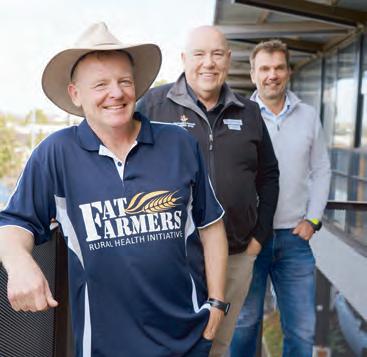


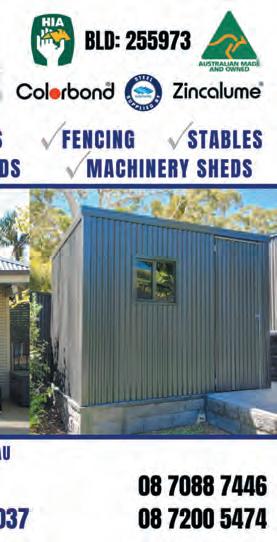
(AGBU) based at the University of New England (UNE), these updates will give sheep producers a much more thorough interpretation into how their flock fares against the broader industry for these important traits and indexes.”
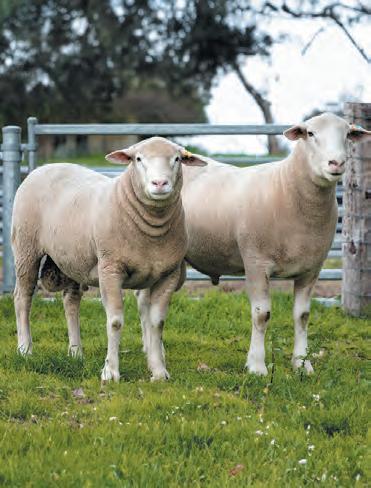



Annual sale at Richmond Park White Suffolk and Mulgundawa Poll Dorset Stud.
The principals sincerely thank all who considering purchasing terminal or stud sires from them in 2023.
They are committed to producing sound rams with the genetics that prime lamb producers need to continually improve profitability.
Mulgundawa Poll Dorset continue to be above breed average for the profit driving traits of weaning weight, post weaning weight, eye muscle depth, lean meat yield and dressing per cent.
The sires used to produce the 2024 sale offering will include new genetics from:
Ivadene 64/21, top 10 per cent WWT and TCP, Top 20 per cent PWT and Top 5 per cent PEMD, LMY and Dressing per cent. Good length and neck extension.
Ivadene 287/21, 10.5 for WWT, 16 for PWT, 2.8 PEMD. Top 20 per cent for TCP and top 5 per cent LMY.
Warburn 286/21, low BWT, 0.05 and high yielding 2.7 PEMD. Well suited to young ewes he has exceptionally clean points.
Newbold 27/19, low birthweight 0.06 and 3.3 PEMD (top 10 per cent) has progeny again this year and continues to breed sound, deep-bodied sheep.
Excellent son retained in stud.
Ivadene 171/20, top 5 per cent for PEMD, LMY, Dressing per cent and top 10 per cent for TCP.
Ivadene 451/20, top 5 per cent for WWT, PWT, LMY. Top 10 per cent for Dressing per cent and top 20 per cent TCP.
Has produced a great son, retained in stud.
Richmond Park White Suffolks are above breed average for weaning weight, post weaning weight, lean meat yield and Maternal Carcase Production.
MCP indicates suitability for maternal ewe production.
The 2024 sale team will have progeny from:
· Ashmore 170/20, low BWT and top 10 per cent PEMD and top 20 per cent for TCP.
Wingamin 2715/20, top 5 per cent for WWT, top 10 per cent PWT, son of Warburn 48/16. Top 10 per cent MCP.
· Farrer 106/19, low BWT and top 5 per cent for WWT, PWT and TCP. Top 10 per cent MCP.
Richmond Park 406/20, top 10 per cent for WWT, PWT and LMY. Top 20 per cent MCP.
· Richmond Park 103/21, top 20 per cent for PEMD, LMY and Dressing per cent. Top 5 per cent MCP.
Buyers will find rams from both breeds to produce trade or export lambs from either mature or young ewes, composite, merino or 1st cross mothers.
Flocks are MN3V (JD vacc), Bruc Acc free #35, and 7in1 vacc.
For more complete information please visit their website www.richmondparkmulgundawa. com/ or Facebook page. Look for their QR code.
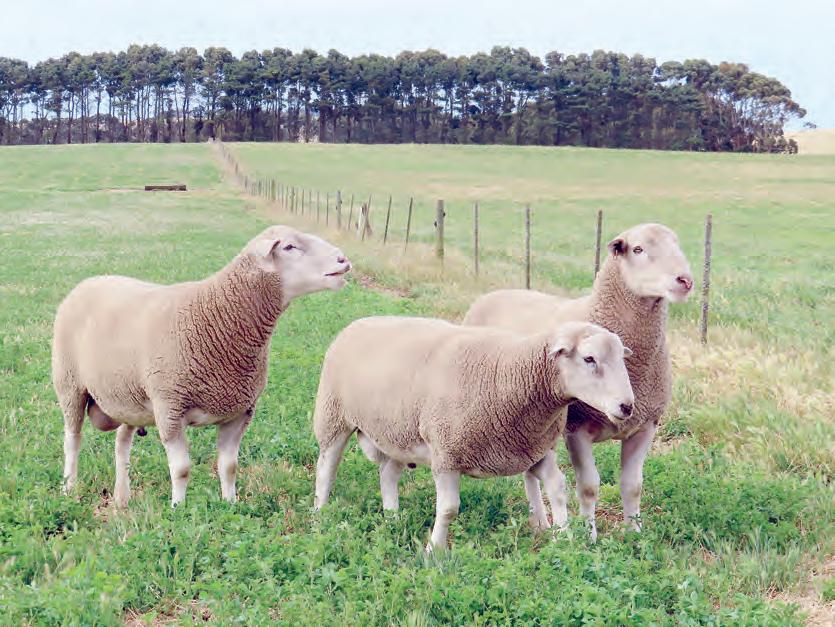
Meat & Livestock Australia (MLA) has announced a new Lamb co-products compendium, showcasing the opportunities available for co-products for sheep and lamb.
In 2022, the estimated export value of sheep co-products was valued at $113 million.
According to MLA’s Group Manager for Science and Innovation Michael Lee co-products offer a range of product opportunities for processors and consumers.
“Sheep and lamb co-products comprise a significant proportion of the returns from animal processing, and proper utilisation of coproducts will generate greater value for each carcase through the supply chain,” he said.
“In 2009, MLA released a large manual called the Co-Products Compendium, which included yields and descriptions of offal, bone, blood by-products and skins derived mostly from beef cattle, but also lamb and sheep.
“The Science & Innovation team have updated this and specifically designed it around lamb and sheepmeat only.
“The compendium is filled with the latest yields and images and examples of what we now refer to as the fifth quarter and we have seen recent innovation successes in nutraceu-
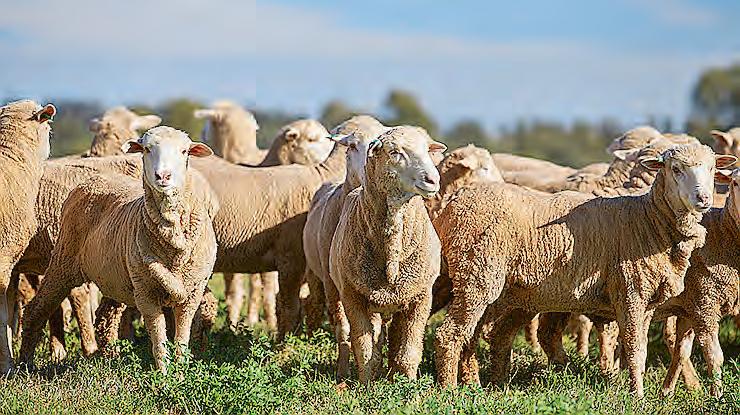
ticals, pet food treats and collagen drinks using co-products from sheep and lambs.”
In many cases, co-products offer more opportunities for innovation and profit than com-
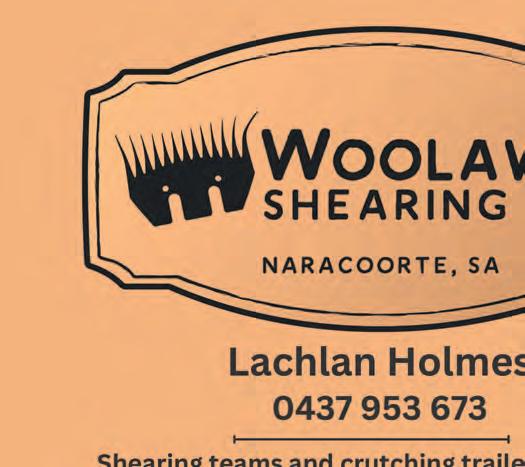
The compendium notes that, in general, the highest value can be obtained by packing co-products for edible use. Pet food has the second highest value and rendering is the least value.
The compendium examines these uses of co-products, as well as rendered products like bone meal and tallow and skins and pelts.
Within the co-product breakdown are various forms of information including market volumes and uses, typical costs for processors and regulations and market access.
“The lamb co-products compendium highlights the potential for significant improvements to the current value of lamb co-products. We can now share that knowledge for industry to enter the co-products value adding sector,” Mr Lee said.
“In all cases, customers are seeking a relationship with the processor to provide a consistent supply in terms of volume, quality and price. Opportunities exist for the co-product supplier to work with manufacturers seeking co-products to establish ongoing supply chains beneficial to both parties.”
To view the latest Lamb co-products compendium, please visit the MLA website.






ELECTRONIC identification (eID) tags are replacing visual tags for sheep and farmed goats.
Moving from the visual tag and mob-based system to eID will greatly improve the accuracy and efficiency of livestock traceability.
eID devices contain a radio frequency identifier (RFID) microchip that can be read using a handheld scanning wand or panel reader.
This allows animals to be individually identified through the NLIS.
The eID technology is well developed and was first implemented for cattle in South Australia in 2004.
Many SA sheep and goat producers are already using eID technology to assist with onfarm management and production decisions.
Victoria introduced mandatory eID for sheep and goats in 2017.
Moving from the visual tag and mob-based approach to individual eID will improve the accuracy and efficiency of livestock traceability.
South Australia is working with the federal and state governments and industry to transition to eID.
For many producers, the only change will be switching from a visual tag to an eID device.
Most eID tags can be applied with the same applicator as used with visual tags.
The year-of-birth colour system for eID tags remains voluntary in SA and is used by most producers for management purposes.
The state government has committed funding to support the first stage of eID for sheep and farmed goats.
Discounted eID tags are available to South Australian sheep and goat producers with an active property identification code (PIC). An agreement has been made to provide a $0.95 discount per NLIS accredited tag with these manufacturers: Allflex Australia

Datamars
Enduro Tags
Leader Products
Shearwell
The discount will be applied by the retailer or tag manufacturer at the time of purchase.
As a producer, you should not need to complete an application form or any additional paperwork.
The discount applies to NLIS accredited eID tags aligned to the year-of-birth colour system: black eID tags for 2024 (discount available from 1 January 2024 to 31 December 2024) white eID tags for 2025 (discount available
from 1 January 2025 to 30 June 2025).
The point-of-sale discount is targeted at producers with breeding stock being kept beyond January 1, 2027, and for sheep and goats born on or after January 1, 2025, in line with national start dates.
This rebate was expanded to include eID tags purchased between 2023 and 2025 that are not aligned to the NLIS year-of-birth colour system. SA sheep and goat producers with an active property identification code (PIC) can apply for a rebate on the purchase price of eligible eID devices of 50% up to a cap of $0.95 (GST exclusive) per tag:
2023, black, white, orange, light green, purple, yellow, red 2024, white, orange, light green, purple, yellow, red, sky blue
2025 (until 30 June), black, orange, light green, purple, yellow, red, sky blue
The rebate excludes: pink post-breeder tags, colours outside of the YOB colour system (for example: brown and grey) and non-NLIS accredited devices tags that align to the current YOB colour that have had a point of sale discount applied. The state government would also support 75 per cent of the cost of essential infrastructure required by saleyards and processors for implementing eID across the supply chain.
South Australia’s eID implementation timeline
From January 1, 2025:
Sheep and farmed goats born on or after January 1, 2025, will need to be identified with an NLIS-accredited eID tag before leaving their property of birth.
Processors must be ready to scan sheep and farmed goats identified with eID tags and record individual movements on the NLIS database.
Producers who conduct property to property (P2P) movements must be ready to scan sheep and farmed goats identified with eID tags and record individual movements on the NLIS database.
From July 1, 2025:
Saleyard operators must be ready to scan sheep and farmed goats identified with eID tags and record individual movements on the NLIS database.
From January 1, 2027:
All other sheep and farmed goats leaving a property will need to be identified with an NLIS-accredited eID tag.
MEAT and Livestock Australia (MLA) has announced the release of a brand new podcast which aims to help sheep farmers utilise the best genetic tools available for their animals.
The podcast, titled Ewe-niquely Genetics, was created to explore Sheep Genetics through interviews with experts in the subject such as scientists, historical figures from Sheep Genetics history and breeders.
MLA Sheep Genetics manager Peta Bradley said the podcast was a way for the MLA to engage with producers in more meaningful and impactful ways.
“Agriculture is an ever-changing landscape, and we recognise our clients have busy and dynamic businesses,” Ms Bradley said.
“Podcasts are an easily accessible and popular method of communication for producers.
“Producers can listen at any time, relisten

if needed and when it suits them; the content can be listened to in their home, car or in the paddock.
“Developing and maintaining a podcast also allows the Sheep Genetics team to cater content to suit the time of year and distribute relevant information in a timely manner.”
The Ewe-niquely Genetics podcast now aims to maintain and further increase the high level of knowledge and understanding of the world-leading Sheep Genetics analysis to ram breeders.
It will share more information on genetics in an easily-to-understand style, enhancing the understanding and knowledge of genetics to the wider agricultural industry.
While the first episode released on Spotify on May 1, further episodes will now continue to release on a fortnightly basis.
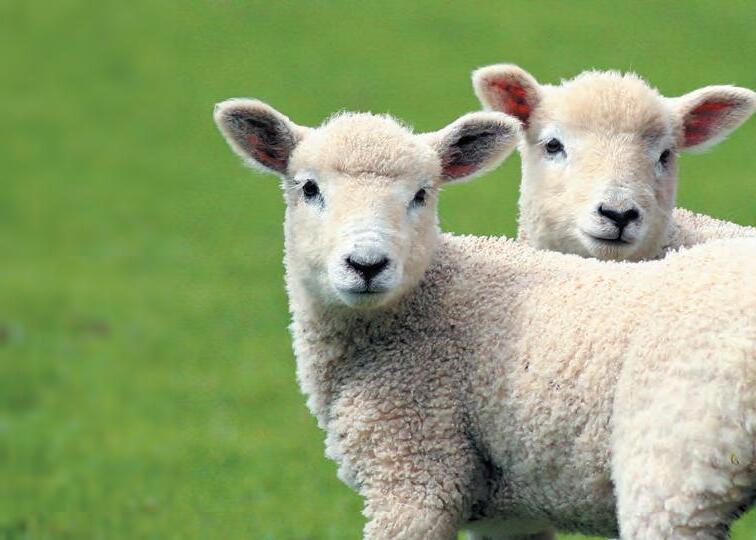


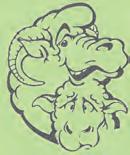

PRIME lamb rams that offer producers flexibility and breed quality progeny have cemented Janmac stud as a commercial seedstock specialist over the past two decades.
This year brothers Grant and Bryce Hausler and their families will hold their 20th Annual Ram Sale at Goroke, Victoria.
Mr Hausler said that one of the greatest aspects of achieving the 20-year milestone was that the stud continues to produce the high-quality stock that their father had initially established.
“I’m proud that Bryce and I have continued what he started, and now with my son Carl returned to the farm, it will carry on,” he said.
“We have maintained that high standard and continue to sell more rams each year - with approximately 250 rams being sold a year, we are really making a difference in the industry.”
Another highlight has been the people they’ve met over the past 20 years.

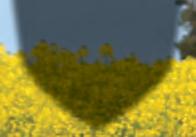
“It is our business of course, and we like it and think we do it well. Along the way we meet friends and great people and this is something we value as a family,” he said.
The years of industry experience means that despite the industry facing tough market and seasonal conditions in the past 12 months, the Janmac team is optimistic about what’s to come this year.
“We are going to see some really good prices this spring for lambs; we are really upbeat about that,” Grant said.
“Comments I am hearing from agents is that prices are going to very good for a well finished article - if we get 800c/kg it is about $60 more than last spring per lamb
“Although we are going to need it due to higher feed costs, it also put us back at the profitable end”.
Grant said they were facing the most difficult autumn and early winter most people in the re-

gion could recall, which was why breeding flexibility was key.
“Our sheep are the ones that we know can do that - the rams we breed and the lambs they leave have capacity to grow on and be shorn, or when the feed comes on they can turn off as suckers or if there is a market for stores they can do well there as well - we can meet lots of markets,” he said.
Despite the challenging season it is “business as usual” at Janmac, with Grant of the opinion that if it has been working for the past couple of decades, then it will continue to work for their milestone 20th Sale.
“What we do as breeders plays a role in how much money people make, so when you set a breeding aim you work towards it, you can’t chop and change looking for a silver bullet,” he said.
“We are again presenting at this year’s auction a strong group of top end rams that present very well and would suit stud operations.
“The rams have plenty of depth and just a touch more muscle as a group this year - we have targeted slightly more muscle in our rams without losing the length and the frame we are known for.”
Janmac will offer 200 Poll Dorset and White Suffolk rams at their 20 th Annual On-Property Production Sale this year, to be hosted at their Goroke Sale Shed from 1pm, Victorian (AEDT) on Wednesday October 2.
Buyers or buyer agents are welcome to come along on Sale Day to secure their pick of the pens as the auction will not be interfaced online this year.
The Hausler families look forward to hosting clients and friends as we celebrate 20 years of Annual On-Property Ram Sales at Janmac.
For the latest news and sale updates, please visit www.janmac.com.au or Janmac Facebook and Instagram Page.

















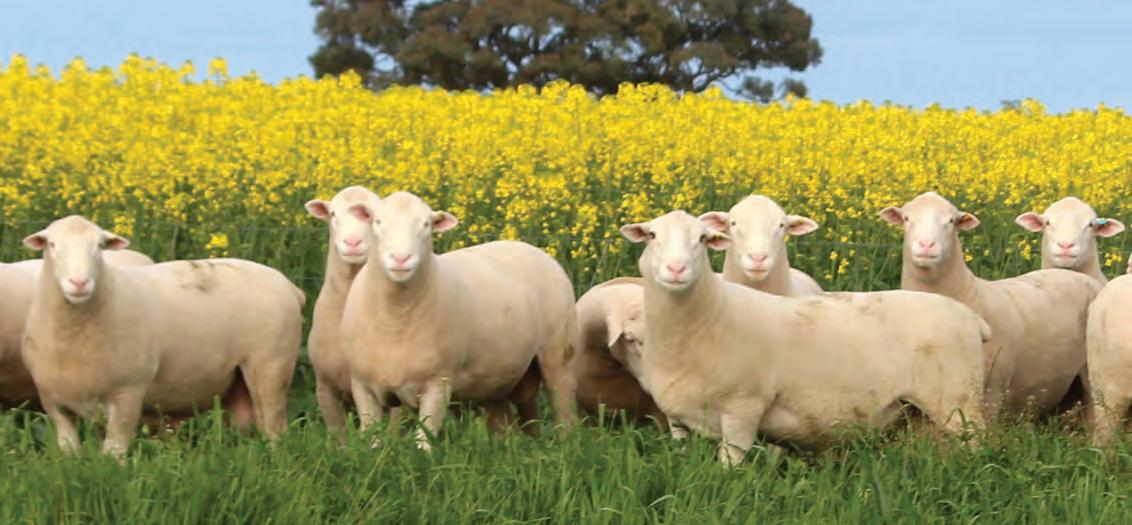




DEPENDING on where you farm, the current seasonal conditions have been very challenging and expensive.
Add to this the sheep and lamb market situation over the past 12 months and it’s a stark reminder that we can’t take our income for granted.
With inflation, interest rates and labour shortages all combining to increase our business costs, we need to think about simplifying our lamb production system. Many factors lie beyond our control - all we can realistically do is manage around them, by controlling the things we can control.
Redesign your sheep flock through genetics to permanently reduce or eliminate challenges and risks within your control.
REDUCE LABOUR: Our ‘Nudie’ sheep do not require shearing or crutching, massively reducing workload, costs and stress. Minimal drenching and zero footbathing or jetting also reduces labour and risk (if these jobs are not completed correctly, or on time).
REDUCE CHEMICAL REQUIREMENTS: Our Nudies have the highest worm resistance of all breeds in Lambplan.
They receive their last drench at 1.5 years of age and are never footbathed or jetted.
High worm resistance is linked to a stronger immune system, giving a better response to vaccines and overall lower death rate.
REDUCE YOUR EXPOSURE TO CHANGING CLIMATIC CONDITIONS: Each year is different presenting its own unique challenges, as livestock managers we need to be prepared for all possible outcomes.
Wet seasons increase the chance of fly waves, worm burdens at irregular times, foot problems and reduced access to shearers. Our Nudies aren’t susceptible to these issues.
Dry seasons strain incomes, increase feed costs, and demand additional labour for feeding stock.

Our sheep are positive for genetic fat and muscle, so will store more energy during times of excess feed, and as they don’t grow much wool, they require 15 per cent less feed to maintain condition, reducing fodder costs.
Low Footprint Lamb started producing lamb
and mutton from shedding sheep run in blue gum forestry blocks in Southern Victoria, where they were mustered twice a year. A simple system with robust sheep, requires lower inputs and is at less risk.
The flock is now fully pedigreed, and perfor-
mance recorded in Lambplan (with a 5 star data rating) and benchmarked against all maternal breeds.
Check out our flock in Lambplan, visit our website at lowfootprintlamb.com.au or call Matt Kelly on 0427 778 254 for more info.

LAMPARDS intention is to make your life easier.

They want to make lamb marking hassle free for you.
To do this, they take care of all administration and appropriate insurances, they source the reliable staff and complete the jobs you need done.
Their teams are made of reliable, hardworking and passionate staff members.
They understand that farming is a demanding profession with a never-ending list of tasks.

That’s where Lampards Lamb Marking can assist you.





Providing an experienced professional team to tackle labour intensive jobs.
Whether you need help with seasonal tasks or on ongoing farm management, Lampards can support you.
We understand that some farms have very particular needs, and we are happy to speak with you regarding what you need to see out a successful lamb marking season.

WITH 240 lots on offer at Woolumbool studs annual on-property auction this year, there is sure to be a ram to suit every producer’s needs.
The Clothier family will offer Poll Dorset, White Suffolk and Multi Meat sires in October, and despite the season being incredibly tough the rams are looking great and growing well.
Woolumbool principal Aaron Clothier said they had some good rainfalls now, but it was a very slow start.
“It has been tough for everyone and there has been lots of feeding going on that doesn’t usually happen at this time of year and it is still required,” he said.
“But it is greening up and if current weather continues should have a good spring growth season leading up to the sale.”
Objective measurement has been a priority tool at Woolumbool since its introduction into the industry, and the extensive data collection and consultation has led to impressive results.
All the White Suffolk rams in this year’s offering have Lambplan values in the top 10 per cent or better for the Lamb Eating Quality (LEQ) index, while the Poll Dorset lots are all in the top 20 per cent or better for the same index.
Lambplan describes the LEQ index as balancing large improvements in eating quality with modest increases in lean meat yield and includes emphasis on worm egg count ASBVs - all traits of importance at Woolumbool.
“LEQ is the index we use as a driver, as it helps us select the top performers, and then we drill down on the individual traits such as post weaning weights and fats, as well as ensuring they are structurally sound and typical of breed,” Aaron said.
“Another big focus has been on meat eating quality with shearforce, intramuscular fat and lean meat yield.
“We believe that is where the lamb markets

are heading, and we try to be on the forefront of what the processors are chasing- so when they flick the switch to pay for yield and eating quality, we want to be supplying those sheep that are right for the job.
“That doesn’t mean they are taking their foot off the pedal when it comes to breeding low birth weights and high growth rates.
“And as always one of the things we are chasing is worm egg count.
“We see that if we can reduce the number of times we have to drench the sheep it is better for everyone.”
White Suffolk sire lines which will be present in this year’s sale include Farrer 210275, a ram with ASBVs in the top one percent for post weaning weight, shearforce, dressing percentage and lambing ease direct, as well as Triggervale 211456 and Waratah 210028.
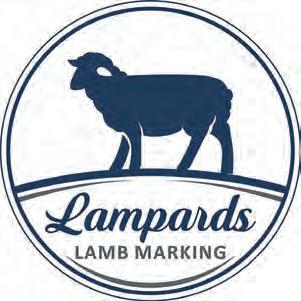








Homegrown sire Woolumbool 221507, in the top one per cent for post weaning eye muscle depth, IMF, dressing percentage and lambing ease direct, will also have sons in the sale.
Poll Dorset sire lines will feature Bruan 190007 - in the top 10 per cent or better for both Terminal Carcase Production and LEQ Index - and Newbold 210016 a ram in the top five per cent or better for all Lambplan indexes.
Woolumbool also offer their clients a maternal ram option in their Multi Meat line - composite breed based on elite genetics of various highperformance breeds which carry the high fecundity Booroola fertility gene.
This year the Multi Meat rams on offer will nearly all be in the to 20 per cent for yearling fibre diameter.
“We have been chasing fibre diameter, a lot of
people have swung away from wool, but we still see it as a valuable asset to the first-cross ewe and if we can make that wool more valuable all our clients will see the benefits,” Aaron said.
“Our crossbred lambs from Multi Meats over Merino ewes were around that 23-micron mark again this year - that is nearly as fine as your Merino lines - and clients find it a much better option than having a 30 micron fleece.”
The 37th Annual Woolumbool On-Property Sale will be held at 12pm South Australian time on Wednesday October 2 at the Yacca Downs Woolshed, Woolumbool, and via AuctionsPlus. All rams are fully paddock reared, with minimal supplementary because of the season. For the latest news and sale updates, please visit www.woolumbool.com.au or Woolumbool Studs Facebook Page.



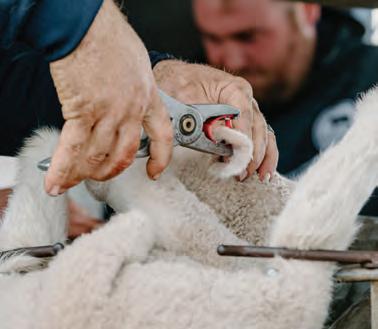
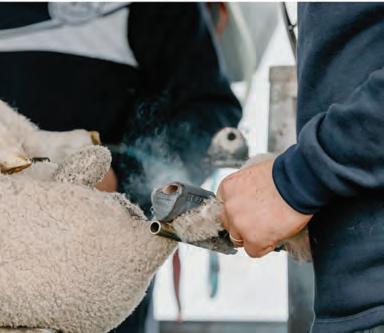

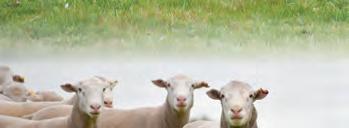















THE 11th annual on property ram sale for the Castle Camps Border Leicester and White Suffolk studs will be held on Friday, September 27 starting at 11am.
This year will see 80 White Suffolk and 70 Border Leicester rams be offered.
The ongoing support from our clients over the years has allowed us to purchase quality genetics in both breeds and this is been reflected in the rams we are able to offer each year.
We feel that this years sale rams will see this continue.
This year’s sale will again be on Auctions Plus.
This will give the opportunity to those who can’t attend on the day to participate in the sale as well. You are also more than welcome to arrange a presale inspection.
This year’s offering of White Suffolk’s will again include rams by Days 20/ 180 (purchased for $15,000) who was the sire of our top price ram last year.
He is ranked in the top 5 per cent on the TCP indexes, being in the top 10 per cent for Pwt, and the top 20 per cent for both Lmy and Emd.
He has breed very well for us and we are again looking forward to offering his progeny at this years sale.
Added to this will be rams from our other proven sires including Glengarry 18/8030, Days 18/82 and Castle Camps 19/10. All three have produced many top sale rams.
Completing these sires are our two new sires Days 21/300, top 5 per cent for Pemd and Castle Camps 21/131a long ram who is in the top 10 per cent for inter muscular fat.
The Border Leicester offering will see the first sons of Gleneith 20/151 (purchased for $13000) he sits in the top 5 per cent across all four Maternal selection indexes.
We feel he will be a major influence in our stud in the coming years.

TOP RAM: This year’s offering of White Suffolk’s will again include rams by Days 20/ 180 (purchased for $15,000) who was the sire of our top price ram last year.
Other proven sires that have breed very well for us in recent years including Castle Camps Barney 17/357 in top 1 per cent for Wec, Paxton 19/398 in the top 5 per cent for Pwt, Castle Camps Wilson 4 th 18/534 a good carcase ram that is in the top 20 per cent for Mwwt.
Added to these are three excellent home breed sires in Castle Camps Paxman 21/501, Castle Camps Wilson 5th and Castle Camps Colt who have breed very well in their first year.
Rounding off our Border sires are the two AI rams Gleneith 21/98, a half brother to Gleneith 21/151, and Linton 21/748 top 5 per cent for Pwec.
Both these rams have left some very good progeny.
Again many of the Border Leicester rams offered will have negative worm egg counts (WEC) a trait that is considered very important at Castle Camps with most of the sires represented in the
catalogue having a negative WEC.
This includes Castle Camps Barney 17/357 who is the ranked second for the Border Leicester breed in WEC at -61.36 and Linton 21/748 at 50.34
Over the years wool quality has also been important to us.
While we don’t offer individual micron tests on our rams we feel that the importance we have placed on wool is reflected in our own First Cross ewes.
Results from last year’s lambs saw them testing at 22.9 micron and 74.3 per cent yield and a sale price of 577cents.
At Castle Camps we continue to run our stud operation with a commercial focus in mind with importance placed on sheep with good natural doing ability.
Our stud ewes are run under commercial con-

SALE: The Annual on property ram sale for the Castle Camps Border Leicester and White Suffolk studs will be held on Friday, September 27 starting at 11am.
ditions and our young rams are run through the summer and autumn with only minimal supplementary feeding, although this year they have been receiving more than normal.
This gives us confidence that our rams go on and perform well for our clients.
This is reflected in the continued great feedback we get for both breeds.
Our clients continue getting excellent results with both lambs and their first cross ewes whether selling over the hooks, on line or through the sale yards.
The 11th Annual Castle Camps sale will be held on the property at 2018 Riddoch Highway, Keith and Auctions Plus on Friday, September 27 starting at 11am, with inspections from 9.30am. We invite you to come and inspect the rams either on sale day or before the sale.
You can also follow us on Facebook or go to our website www.castlecamps.com.au for our online catalogue which will be available from early September. Or just give Ian a call on 0438 566 030 if you have any questions or to arrange a suitable time for an inspection before the sale.

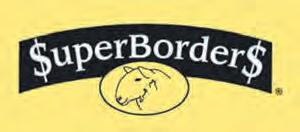


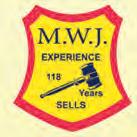

THE release of the Sheep Sustainability Framework’s (SSF) 2024 Annual Report has revealed the broadest range of data to date on the sustainability performance of the Australian wool and sheepmeat industry.
Established by Sheep Producers Australia and WoolProducers Australia and supported by Australian Wool Innovation (AWI) and Meat and Livestock Australia (MLA), the SSF is now in its fourth year of data collection and reporting.
SSF Board Independent Chair Angus GidleyBaird said they were thrilled to be launching the latest snapshot of the industry’s sustainability credentials.
The SSF reports metrics within a framework of four themes - caring for our sheep, enhancing the environment and climate, looking after our people, our customers and the community, and ensuring a financially resilient industry.
SSF Steering Group Chair Dr Scott Williams said a significant amount of work had been done during the year to fill in data gaps with new metrics and better align metrics between the SSF and Australian Beef Sustainability Framework.
“The SSF is constantly evolving, seeking to move with the science and meet the increasing demand from consumers and industry stakeholders for transparency and performance when it comes to sustainable production of sheepmeat and wool,” he said.
“The latest report shows that progress in critical areas for our industry also allows us to shine a spotlight on the challenges we need to tackle head on.”
Reported for the first time in the SSF, sheep producers were asked to rate their satisfaction with their ‘life as a whole’ as part of the Global Life Satisfaction Index, which encapsulates their standard of living, health, what they are achieving in life, personal relationships, safety, feeling part of their community and future security.

Their score of 76.1 per cent was higher than the overall Global Life Satisfaction for Australia (69.4 per cent).
Sheep producers have shown a growing interest in measuring their farm greenhouse gas (GHG) emissions.
The latest National Producer Survey found the percentage of producers using carbon accounting or another process for their enterprise had risen to 9.9 per cent, up from 3 per cent in the 2022 National Producer Survey.
Other highlights included
- Baseline data showed 72.6 per cent of producers are undertaking deliberate activities to
measure, maintain or enhance biodiversity.
- The percentage of wool declared as non-mulesed has increased to 18.6 per cent for Merino (from 15.8 per cent) and 47.1 per cent for nonMerino (from 40.1 per cent).
- The appropriate use of pain management for mulesing, castration and tail docking continues to improve year-on-year.
- The gross value of the Australian sheepmeat and wool industry has jumped 8.9 per cent in a year to $7.7 billion.
Challenges
Access to labour remains an issue for the industry.
Of the 45,500 people employed in the sheep production and shearing sector, 40 per cent of the workforce is aged 55-74, and 72 per cent is male.
The adoption of basic Workplace Healthy and Safety (WHS) practices, such as risk assessments and worker inductions, is relatively low.
In 2023, the National Producer Survey asked producers to rate the extent to which availability of general labour was an issue for their operation.
More than four in every 10 producers (42 per cent) reported major issues with finding general labour, representing was a 7 per cent increase since 2022.
The story is slightly better for shearing labour, although 35.3 per cent of producers reported issues with the availability of shearers, which is a 3.5 per cent decrease since 2022.
Looking ahead, Mr Gidley-Baird highlighted moves in Europe, the US and Australia to regulate ESG reporting as one of the key challenges for the industry in 2025.
“It also reinforces the need for the Sheep Sustainability Framework, which is helping ensure a proactive position for the Australian industry, and is working to align with the Global Report Initiative to support our value chains,” he said.
Dr Williams said a major undertaking had been the development of a new digital dashboard published of the SSF’s website.
“The dashboard showcases current and historical data in an interactive format that will be updated with new information as it becomes available,” he said.
“It is a valuable tool for communicating the Australian sheep and wool industry’s amazing sustainability story.”
For more information and to read the 2024 Annual Report online visit Sheep Sustainability Framework (SSF) Annual Report
















SHEARWELL Australia has expanded operations in South Australia and has recently employed Dan Roe as their new Business Development Manager based in Adelaide.
Mr Roe is well known in livestock circles after spending the last four years at one of Australia’s largest animal genomics laboratories, where he worked with sheep clients across the country.
His passion for using data and technology to enhance the efficiencies of sheep breeders extends from his personal endeavors with his own flock of Poll Dorset sheep in South Australia.
While traditional methods of livestock operations remain crucial, Dan believes that technology is revolutionizing the use of on-farm data.
By leveraging this data, breeders can make more informed decisions, accelerating the progress of livestock breeding and management.
Mr Roe’s background in agricultural science, practical knowledge gained through working alongside the sheep industry’s most innovative producers will help you in making key contributions in advancing your livestock operation through effective collection and use of on farm data.
Mr Roe said that it all started with putting in the electronic ear tags or eIDs.
“As Australia transitions to mandatory eID for sheep and goats from 1 January 2025, producers should ‘do it once and do it right’ and use Shearwell tags which have been designed with better retention in mind and that are made in Australia,’ he said.
Shearwell eID tags are made in Victoria and have speedy turnaround times from order to dispatch from their Bendigo factory.
Mr Roe said that Shearwell has the identifiers, the applicators, stick and panel readers, and free software to enable NLIS transfers, and to connect to weighing equipment.
“Shearwell have some popular current offers whereby if you buy 950 or more sheep and/ or goat eID tags the customer will be eligible for a free Turbo Tagger and a single applicator,” he said.
“If a customer buys 5,000 or more sheep or goat eID tags they were eligible for a free tagger and a Shearwell Stick Reader as well as free freight.
“Producers also find Shearwell’s customer service second to none.”
For further product information and on-line ordering go to www.shearwell.com.au and/or call 1800 998 934.

By Erin Lukey, Meat and Livestock Australia senior market information analyst
THE sheep market typically follows a strong seasonal pattern.
Prices generally start low at the beginning of the year, then rise moving into autumn, peaking at the end of winter due to a constrained supply of finished lambs, before easing with the arrival of new-season lambs.
In 2024, however, lamb prices have been unpredictable and unprecedented, continuing a volatile two years of trade.
Prices started strong in the early sales of the year, reaching near year-long highs.
However, due to a wet summer and decent supply, prices eased for the first three to four months.
High supply and drying paddocks across Victoria and SA affecting producers’ confidence in the future of the market.
Since May, prices have returned to more seasonal trends, with a 30 per cent lift in the last four months significantly impacting producer sentiment.
Despite strong returns across processor lambs in the Trade and Heavy Lamb Indicators, the Restocker Indicators have not felt the same relief.
While restocker prices have lifted by 25 per cent, the Trade Lamb Indicator has increased by 33 per cent and the Mutton Indicator by a solid 38 per cent.
This disparity shows that restocker prices
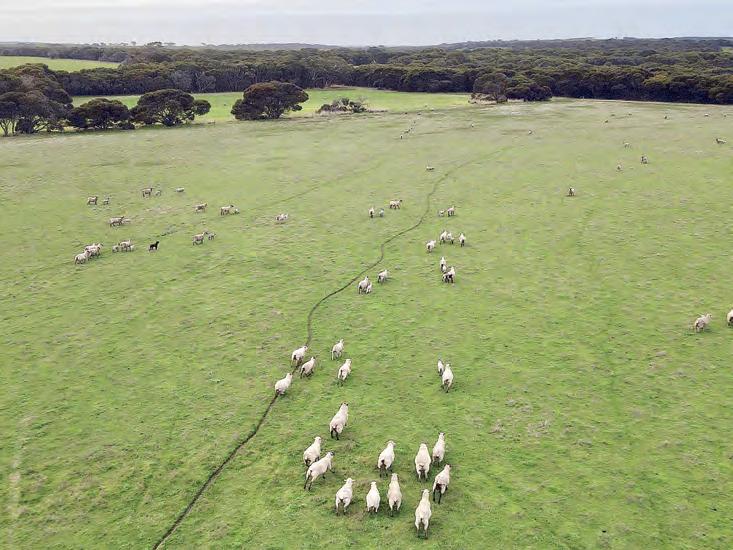
(File)
have not kept pace with the swift recovery of heavier lamb prices, which may continue if finished animals are rewarded.
Late July, trade lambs were receiving 242¢/ kg carcase weight (cwt), the second highest price gap on record, just below the August 2018 high of 250¢/kg cwt.
The premium of 33 per cent over restockers is well above the five-year average of 10 per cent, pushing current market conditions into unprecedented territory.
In the short term, the market saw heavy lamb prices reach levels not seen since 2021, and trade lamb prices higher than those in Feb-
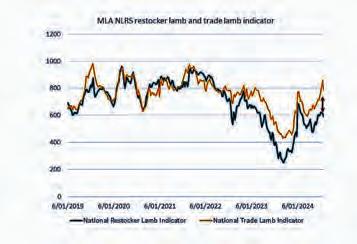
MLA NLRS
ruary 2022.
However, the market corrected with sheep yardings lifting, lamb yardings easing, and all indicators falling by 50–89¢.
The highs were short-lived due to rainfall across sheep country, and reduced enthusiasm from export buyers.
Looking ahead, the market is awaiting the arrival of new-season lambs.
Historically, new-season lambs enter the market through New South Wales saleyards in late July.
Recently, 500 young lambs were sold through the Forbes saleyard, fetching over 930¢/kg cwt.
Although this indicates a slow start to the season, it provides confidence that premiums will be available when young lambs enter the market.







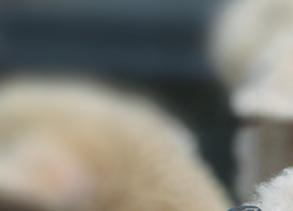




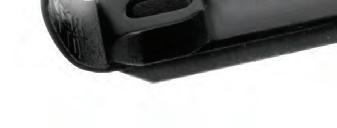
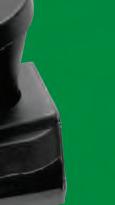
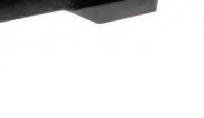
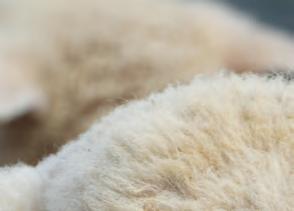
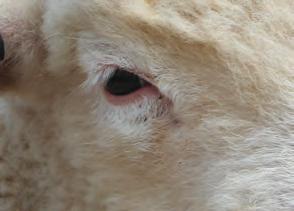

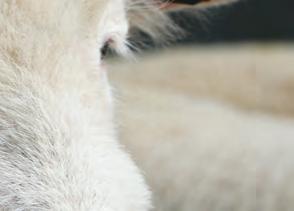

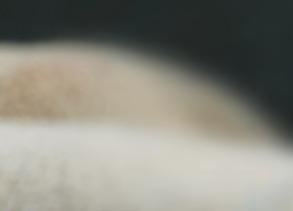


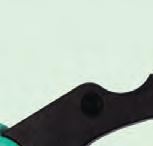

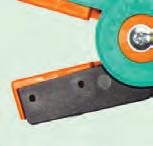




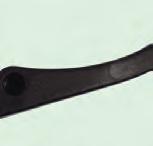

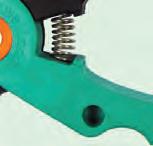




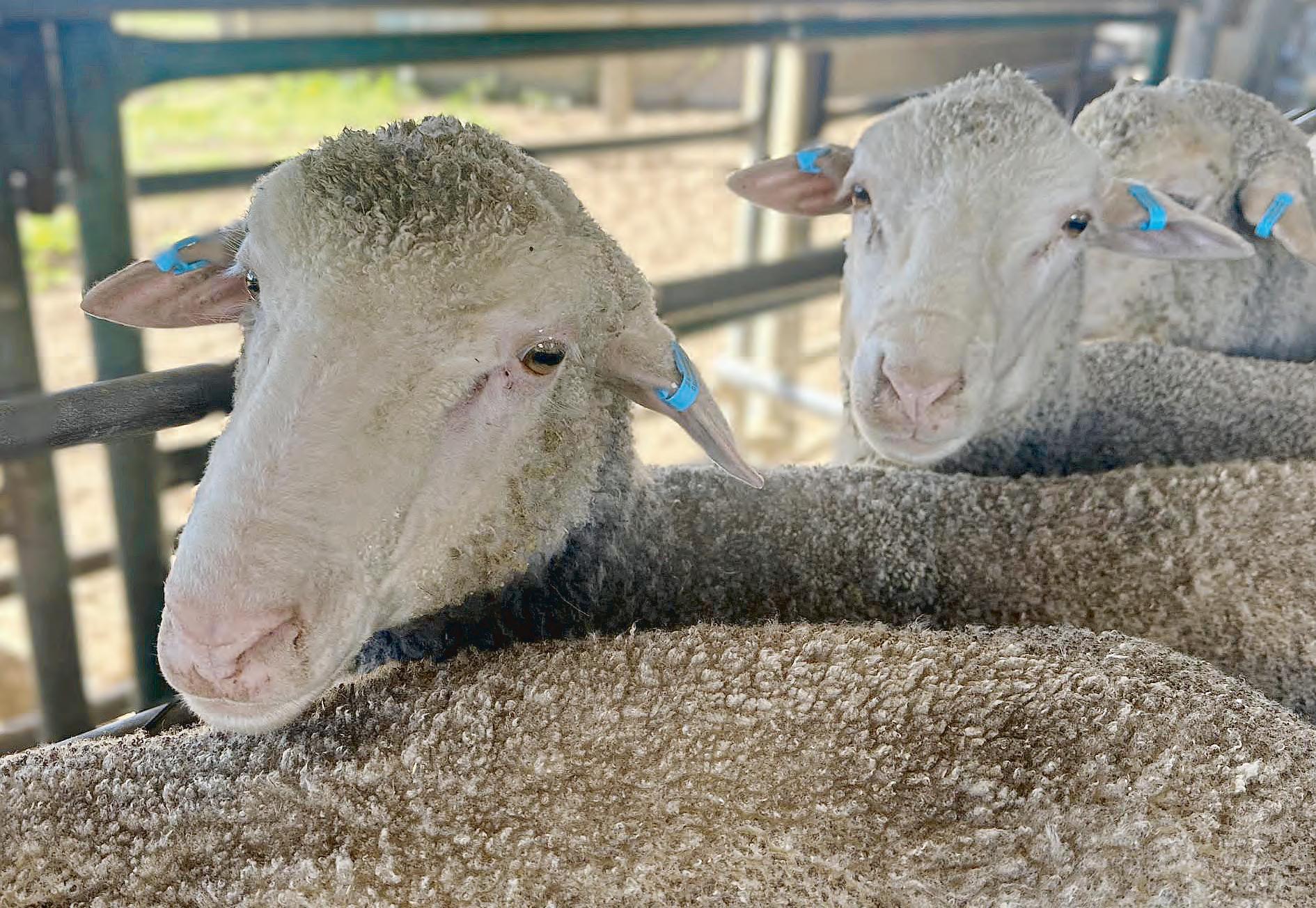
THE Hamilton Pastoral and Agricultural Society has enjoyed resounding success at the 2024 Sheepvention Rural Expo.
This year’s event, held at the iconic Hamilton Showgrounds, has been marked by exceptional weather, increased attendance, and notable highlights have captivated attendees and exhibitors alike.
President David Botterill expressed his satisfaction with this year’s expo.
“We’ve had amazing weather, which has contributed to fantastic crowd numbers,” he said.
“The ACE Radio Innovations Hub and Producers Market – housed in the new shed – has been a real highlight.
“It’s been wonderful to see how well this new space has worked and how it has enhanced the experience for everyone involved.”
A standout feature of the space was the Grange Garlic Kitchen, which, alongside the RIST and South West TAFE interactive areas, drew considerable attention and praise from visitors.
The latter was the recipient of the Best Indoor Trade Display because of its value, while its outdoor equivalent was Brandt, with its impressive line-up of agricultural machinery.
In a prestigious moment the Supreme Champion Merino Ram and Ewe awards were claimed by two outstanding studs.
The Champion Ram title went to Mount Yulong Poll Merino Stud, renowned for its exceptional breeding quality and presentation.
Meanwhile, the Champion Ewe was awarded to Tamaleuca Merino and Poll Merino Stud, celebrated for its superior wool characteristics and overall excellence.
These accolades recognise the pinnacle of Merino breeding and highlight the impressive standards set by these industry-leading studs.
The expo featured several competitive events, showcasing innovation and skill across various categories.
Aussie Wool Pellets’ Sherri Symons was the first-ever female winner of the Robert F. Stewart Best Innovation, with her Planket Pot design.
The Planket Pot represents a significant advancement in sustainable gardening solutions.
Made from 100 per cent Australian wool, the pots help prevent root transplant shock and, biodegrading into the soil, enrich it with essential nutrients.
The Planket Pot’s offer a viable eco-friendly alternative to traditional plastic seedling punnets.
Bree Cudmore secured her name in farm dog excellence, winning the CopRice Victorian Farm Dog Championship for the third consecutive year.
Cudmore’s remarkable performance with her dog, Lanarch Moana, clinched the top spot with an impressive score of 281.
Her consistent success over the years underscores her exceptional skill and dedication to the craft.
Mr Botterill said this year’s expo saw a wellreceived rearrangement of the grounds, which contributed to a smoother flow and a more enjoyable experience for attendees.
“The general vibe around the grounds has been excellent,” he said.
“The rearrangement has worked really well, and the general feeling is that we’ve seen strong numbers.”
The society’s committee has successfully blended the expertise of previous generations with the fresh perspectives of newer members.
“We’ve achieved a great mix of the previous and new generations on our committee,” Mr Botterill said.
“The younger members are bringing innovative ideas, while the more experienced members offer valuable insights from past experiences.
“This balance has allowed us to embrace new initiatives while maintaining a strong sense of
continuity and caution.”
Reflecting on his two-year tenure in the top role, Mr Botterill said he was proud of the progress the committee had made as a team.
“I don’t see this as me handing over the reins, but rather as transitioning to the next phase with a fantastic committee in place.
“I am confident that Dazza (Darren Schurmann), who is stepping up, will continue to lead the society with the same dedication and vision.”
RESULTS
INVENTIONS COMPETITION
Improved and Modified Inventions Class:
• 1st - Sheri Symons, Planket Pot 2nd - Matt Byerlee, Gas Knife Buddy 3rd - Matt Byerlee, Wool Pack Buddy
New Inventions Class:
1st - Trudie Nutt, Twist and Lock Agricultural Fence Tensioner
• 2nd - Joshua Murcott, Mainframe Adjustable Stock Crate
• 3rd - Rohan Giles, Retractable Vaccinator Holder
Robert F. Stewart - The Best Innovation: Sheri Symons, Planket Pot
PROWAY WOOL HANDLING
COMPETITION
Australian Wool Innovation Novice Wool Final:
• 1st - Maddison Kelly
• 2nd - Kasey Griffiths
• 3rd - Ally Tamblyn
• 4th - Hannah Noack
Fox and Lillie Rural Senior Wool Final:
• 1st - Aleisha Rintoule
• 2nd - Amy Kilpatrick
• 3rd - Holly Byrne
• 4th - Natalia D’Bella
RIST Open Wool Final:
1st - Mark Purcell 2nd - Amy Kilpatrick
3rd - James Murphy
• 4th - Lisa Wardlaw CAREERS IN AG AND VAS JUNIOR JUDGING COMPETITION
Junior Judging:
• 1st - Georgie Taylor (Ballarat Grammar) 2nd - Emmy Finlayson (Brummies Blacks) 2nd - Immy Cameron (Noremac Suffolks) 3rd - Rubi Thomas (The Hamilton and Alexandra College)
• 4th - Alfie Price (Good Shepherd College)
• Overall Champion: Immy Cameron (Noremac Suffolks)
Senior Judging:
• 1st - Lucinda Smith (Marleigh White)
• 2nd - Alex Tonissen (Good Shepherd College)
• 2nd - Chelsea Wilkinson (Brightside Stud)
• 3rd - Elli Burgess (The Hamilton and Alexandra College) 4th - Lily Johnson (Jackson Farming)
• Overall Champion: Lucinda Smith (Marleigh White)
COPRICE VICTORIAN FARM DOG CHAMPIONSHIP
1st - Bree Cudmore with Lanarch Moana (281) 2nd - Bree Cudmore with Vera Slim (278)
• 3rd - Andrew Whelan with Whelans Run Burls (275)
4th - Joe Spicer with Gogetta Clue (272) 5th - Laine Eade with Rose (259)
6th - Joe Spicer with Broken River Bank (252)
SUPREME CHAMPION MERINO RAM AND EWE
• Champion Ram: Mount Yulong Poll Merino Stud
Champion Ewe: Tamaleuca Merino & Poll Merino Stud